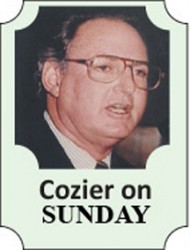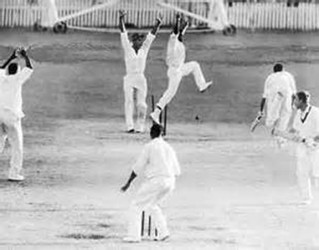By Tony Cozier
IT was inevitable that the current Ashes series, literally now in full swing in Cardiff, should have been preceded by an exultant outpouring of nostalgia from one side.
It is the 10th anniversary of England’s recapture, after 16 frustrating years, of their most treasured prize from their oldest, most antagonistic opponents, Australia. The triumph was all the more satisfying as it was achieved at home in a bruising, pulsating contest that captivated an increasingly disillusioned sporting public. The experience is recent enough for it to be still widely acclaimed in the English media, as it was at the time, as “the greatest series of them all”.
 The spellbinding contest that was the second Test at Edgbaston, won by England by two runs on a still debated catch after a comprehensive loss at Lord’s, remains “the greatest Test” in the contemporary reviews.
The spellbinding contest that was the second Test at Edgbaston, won by England by two runs on a still debated catch after a comprehensive loss at Lord’s, remains “the greatest Test” in the contemporary reviews.
Wisden’s editor Matthew Engel’s assertion in the 2006 edition that it “surpassed every previous series in cricket history on any indicator you choose,” typified the general elation.
The Independent’s Stephen Brenkley claimed that “if there has been a more compelling series, history forgot to record it.”
The forgetfulness was not history’s but Brenkley’s and the majority who shared his notion then and those who do so now.
Perhaps memories were blurred by the hiatus since West Indies’ equally riveting and significant series in Australia in 1960-61.
To borrow Engel’s terminology, on any indicator you choose it certainly stands alongside the 2005 Ashes as “the greatest Test series of them all”; there are cogent arguments for placing it ahead of it.
It began with Test cricket’s first ‘tie’, followed by a victory apiece in the next two matches. It climaxed with Australia’s last wicket pair hanging on for an hour-and-a-half in the fourth Test in Adelaide to earn the draw that set up the last at the MCG as the decider in which Australia scrambled home by two wickets before record crowds (274,404 over the five days, 90,800 on the Saturday).
E.M.Wellings, a noted English writer of the game not known for flattery or hyperbole, described the tie with the excitement of a schoolboy: “I was there. I saw it all…it was the Greatest Test Match, the Greatest Cricket Match and surely the Greatest Game ever played with a ball.”

All to a single delivery, it remains the most statistically perfect of all Tests. The last of the 20 wickets fell to Joe Solomon’s direct hit of the stumps from square-leg with one of the 3,270 balls remaining after five days in which 1,474 runs were scored.
Johnnie Moyes, the renowned writer and ABC radio commentator, labeled it “the most wonderful cricket tour Australia has known.”
In addition to the tie, he referred to a century in each innings (Rohan Kanhai) and a hat-trick (Lance Gibbs), both in Adelaide, the rarity of Joe Solomon’s cap falling onto the off-bail for a ‘hit wicket’ decision in Sydney, “some amazing batting, superb bowling, gorgeous fielding and, above all, happy comradeship on the first and outside.”
It was played at breakneck speed throughout. There were 133 (eight-ball) overs in one day’s six hours; the average never fell much below 14 overs an hour (18 overs at today’s rate).
I was a 20-year-old on the sports desk of the Barbados Daily News at the time, following the fascinating events on the other side of the planet through the ABC commentaries of Moyes, Alan McGilvray and Michael Charlton. Like every West Indian, I was conscious of a host of sociological reasons that embellished the cricket itself.
They were led, belatedly for the first time on tour, by a black captain, Frank Worrell, one of the famed Three Ws triumvirate long since recognized as an exceptional cricketer. He unified a youthful team that played under the flag of the recent, as it turned out, short-lived West Indies Federation. They arrived in Australia to find the white immigration policy still in place.
After the series that former Australian batsman Jack Fingleton termed “this rosy dawn of a cricket renaissance”, the Australia Cricket Board struck the Frank Worrell Trophy for perpetual competition between the teams.
After Worrell spoke during its presentation to his Australian counterpart Richie Benaud, hundreds of spectators in front of the pavilion at the Melbourne Cricket Ground broke into “For he’s a Jolly Good Fellow”; on the eve of their departure a few days later, an estimated 200,000 lined the streets of Melbourne to cheer them as they were driven in an open-top motorcade to a mayoral reception.
Four decades on, I experienced first-hand the comparable impact of the Ashes series during a couple of weeks in England on the way home from a West Indies tour of Sri Lanka.
By then, England had leveled the series with their stunning second Test win. The papers, usually utterly preoccupied with the start of the football season, devoted reams of newsprint to the cricket instead; strolling in the sunshine through a north London park, there was the unusual sight of boys and girls playing cricket, not football. The Ashes seemed to be all my friends, of both sexes, were discussing.
The nation’s fixation with the series was confirmed when the Old Trafford gates had to be closed on as many as 10,000 fans, eager to be there as England pressed for victory on the last day. They came agonizingly close, denied as Australia’s Nos.9 and 10, Brett Lee and Glenn McGrath held firm for the last four overs.
Back in Barbados, live television coverage showed the wild, prolonged celebrations after a draw at the Oval settled the outcome. They were paraded through London in an open-top, double-decker bus. Some 50,000 packed Trafalgar Square to hail them. They were entertained by prime minister Tony Blair; the Queen issued a note of congratulations and awarded the OBE to captain Michael Vaughan and coach Duncan Fletcher and MBEs to every other member of the team.
In Melbourne, such adoration was directed at a visiting team that had been beaten; in London, it was reserved for their own heroes who had delivered an unexpected conquest over the seemingly invincible Aussies. There was a subtle but essential difference.
So 1960-61 or 2005 as “the greatest Test series of them all?”
Judgment on the greatest anything is purely subjective; in my subjective West Indian opinion, the answer to the question is clearcut.





